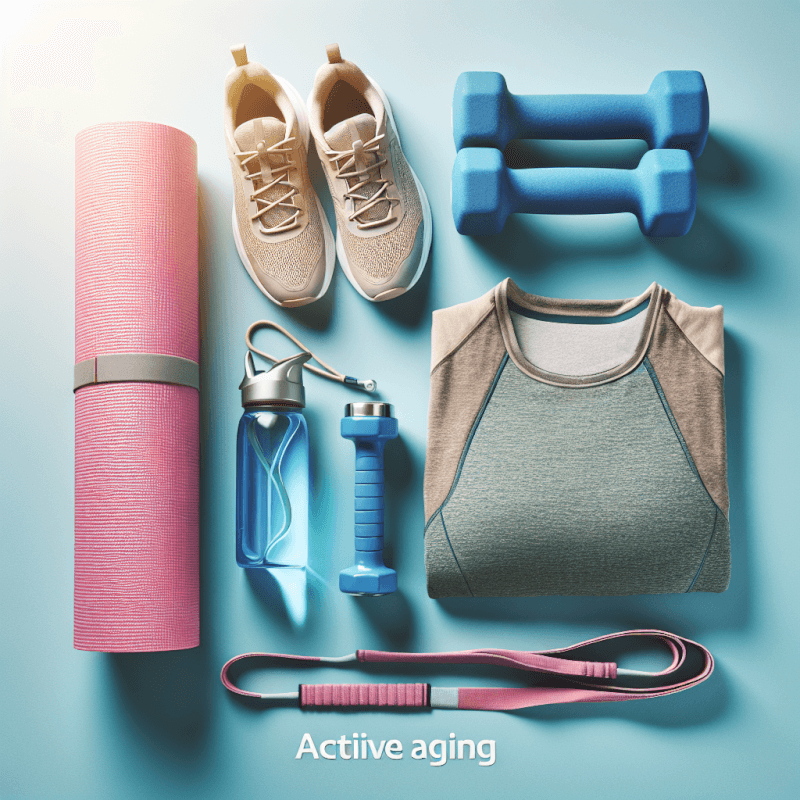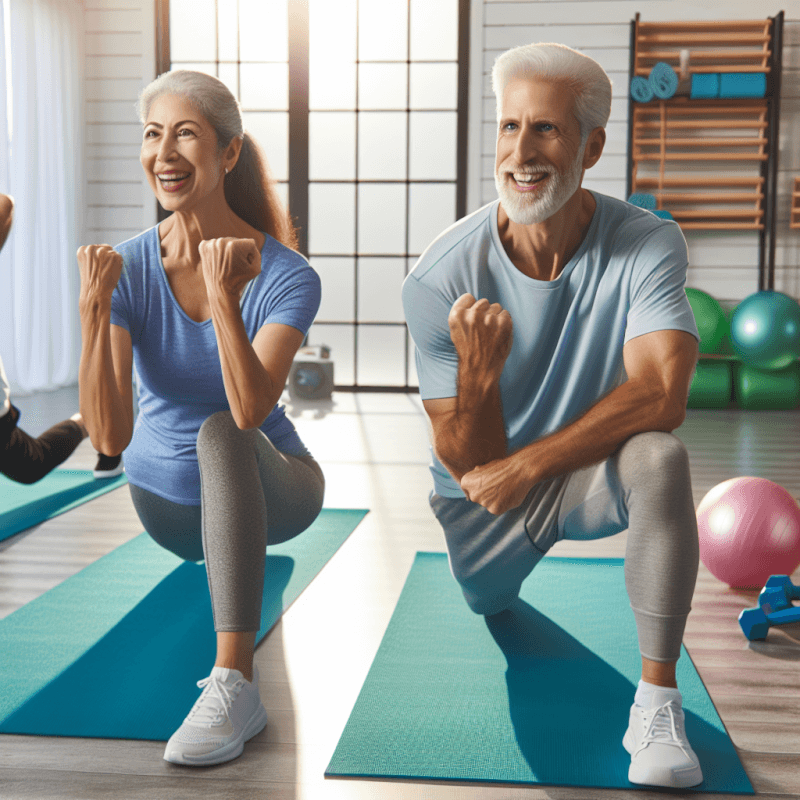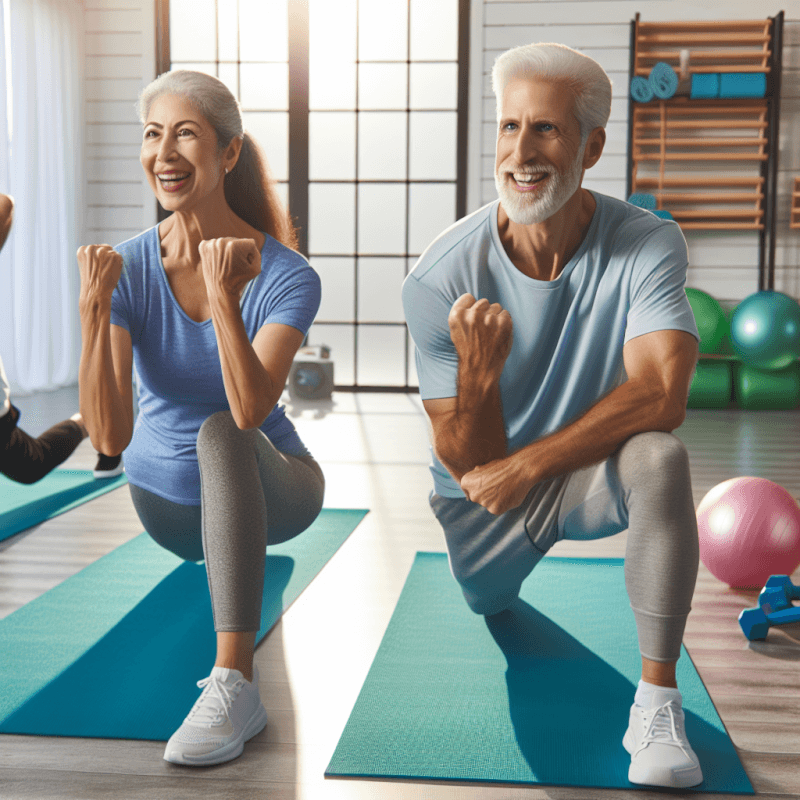Hey there, fitness enthusiasts! Get ready to amp up your exercise routine with some exciting Boomer Workouts. Whether you’re a boomer yourself or simply looking for a new challenge, these workouts are designed to keep your body moving and your spirits high. With a focus on strength, flexibility, and overall well-being, these exercises are tailored specifically for the older generation, ensuring that you can maintain an active and healthy lifestyle. So, grab your gym shoes and get ready to sweat it out – it’s time to redefine what being a boomer is all about!
Benefits of Boomer Workouts
Increased strength and mobility
Engaging in regular workouts as a boomer can have a significant impact on your strength and mobility. As we age, our muscles tend to weaken, which can lead to difficulties in performing daily tasks. However, incorporating strength exercises into your workout routine can help combat this. Exercises like squats, lunges, and bicep curls target key muscle groups, such as the legs, arms, and core, which contribute to overall strength and mobility. By increasing your strength and mobility, you’ll find it easier to maintain an active and independent lifestyle as you age.
Improved cardiovascular health
Another benefit of boomer workouts is improved cardiovascular health. Cardio exercises, also known as aerobic exercises, get your heart rate up and help strengthen your heart and lungs. Regular cardio workouts, such as brisk walking, cycling, and swimming, can improve blood circulation, lower blood pressure, and reduce the risk of heart disease. By incorporating cardiovascular exercises into your routine, you’ll be giving your heart a workout and reaping the benefits of improved cardiovascular health.
Enhanced balance and stability
Maintaining good balance and stability is crucial as we age to prevent falls and injuries. Boomer workouts that focus on balance and stability exercises can help improve your overall coordination and reduce the risk of falls. Exercises like standing on one leg, heel-to-toe walk, and yoga tree pose target the core muscles and enhance proprioception, which is your body’s ability to sense its position in space. By improving your balance and stability through specific exercises, you’ll have more confidence in your day-to-day activities and reduce the risk of accidents.
Reduced risk of chronic diseases
Regular physical activity has been linked to a reduced risk of chronic diseases, such as heart disease, type 2 diabetes, and certain types of cancer. By engaging in boomer workouts, you’re taking proactive steps towards maintaining your overall health and well-being. Exercise helps lower blood pressure, improve cholesterol levels, and regulate blood sugar, leading to a decreased risk of chronic conditions. So, lace up those sneakers and prioritize your health by incorporating regular workouts into your routine.
Boosted mental well-being
Exercise is not just beneficial for your physical health; it also has a positive impact on your mental well-being. Boomer workouts can help boost your mood, reduce stress, and improve mental clarity. When you exercise, your body releases endorphins, which are natural mood boosters. Whether you’re going for a brisk walk, practicing yoga, or swimming laps, the release of these feel-good hormones can leave you feeling happier and more relaxed. Regular exercise can also improve sleep quality, enhance cognitive function, and increase self-confidence, all contributing to a healthier mind and body.
Considerations for Boomer Workouts
Consulting a healthcare professional
Before starting any new fitness routine, it’s essential to consult with a healthcare professional. They can assess your individual health condition, provide guidance on any limitations or precautions you may need to take, and suggest exercises that are appropriate for your specific needs. This step is crucial, especially if you have any pre-existing medical conditions or have been inactive for an extended period. A healthcare professional can help you establish a safe and effective workout plan tailored to your abilities and goals.
Starting slow and gradually increasing intensity
When it comes to boomer workouts, it’s crucial to start slow and gradually increase the intensity of your exercises. Your body may need time to adjust to the increased physical activity, especially if you’ve been sedentary for some time. Begin with low-impact exercises that are less strenuous on the body, such as walking or swimming, and gradually incorporate strength training and cardio exercises. This gradual approach allows your muscles, heart, and joints to adapt and helps prevent overexertion or injury.
Listening to your body
One of the essential considerations for boomer workouts is listening to your body. Pay attention to any discomfort, pain, or fatigue during your workouts. If something doesn’t feel right, it’s essential to modify the exercise or take a break. Pushing through pain can lead to injuries, setbacks, and should be avoided. Remember that exercise should be challenging, but it should never cause severe or prolonged discomfort. By listening to your body and knowing your limits, you can create a workout routine that is both enjoyable and safe.
Prioritizing proper form and technique
Proper form and technique are crucial for maximizing the benefits of your boomer workouts while minimizing the risk of injury. Before engaging in any exercise, take the time to learn the correct form and technique. This may involve working with a personal trainer or fitness professional who can guide you through the proper movements. Doing exercises with improper form can lead to strain on the muscles and joints and may limit the effectiveness of the exercise. By prioritizing proper form and technique, you can ensure that you’re getting the most out of your workouts and reducing the risk of injury.
Choosing low-impact exercises
As we age, our bodies may become more susceptible to joint pain and other discomforts. Therefore, it’s essential to choose low-impact exercises that are gentle on the joints, while still providing the desired health benefits. Low-impact exercises, such as swimming, cycling, or low-impact aerobics, help reduce the stress placed on the joints while still delivering cardiovascular benefits. These exercises can be an excellent option for boomers looking to stay active without risking joint pain or exacerbating existing conditions.

Warm-up Exercises for Boomers
Neck rotations
To begin your boomer workout, perform gentle neck rotations to warm up the muscles in your neck and upper back. Start by sitting or standing with your spine straight. Slowly rotate your head to the right, bringing your chin towards your right shoulder. Hold the position briefly, and then slowly rotate your head to the left, bringing your chin towards your left shoulder. Repeat this movement several times, gradually increasing the range of motion.
Arm circles
Arm circles are a great warm-up exercise to loosen up the muscles in your arms and shoulders. Stand with your feet hip-width apart and extend your arms out to the sides. Begin by making small circles with your arms, gradually increasing the size of the circles. Continue for several repetitions, then reverse the direction of the circles. This exercise helps to increase blood flow to the upper body and prepares your arms and shoulders for more dynamic movements.
Shoulder rolls
Shoulder rolls can help release tension in the shoulders and upper back, which is especially beneficial if you spend extended periods sitting or have poor posture. Stand tall with your feet shoulder-width apart. Roll your shoulders forward in a circular motion, making big circles with your shoulder blades. After several rotations, reverse the movement and roll your shoulders backward. This exercise can help improve mobility in your shoulders and promote better posture.
Hip circles
To warm up your hip joints and improve mobility, perform hip circles. Stand with your feet shoulder-width apart and place your hands on your hips. Begin by making small circles with your hips, gradually increasing the size of the circles. Move in a clockwise direction for several repetitions, then switch to counterclockwise. Hip circles can help lubricate the hip joints, improve range of motion, and prepare your lower body for exercises involving the hips and legs.
Ankle rotations
To warm up your ankles and improve flexibility, try ankle rotations. Sit in a chair with your feet flat on the floor. Lift one foot off the ground and rotate your ankle in a circular motion. Start with small circles and gradually increase the size. Perform several rotations in one direction, then switch to the other. This exercise helps improve ankle flexibility and mobility, which is important for various activities, such as walking, dancing, or climbing stairs.
By incorporating these warm-up exercises into your boomer workouts, you’ll help prepare your body for the upcoming exercises and minimize the risk of injury. Take a few minutes to perform these gentle movements before each workout to ensure that your muscles and joints are ready for action.
Strength-Training Exercises for Boomers
Squats
Squats are an excellent strength-training exercise to incorporate into your boomer workouts. They target the muscles in your legs, hips, and glutes, helping to improve lower body strength and stability. To perform a squat, stand with your feet shoulder-width apart. Lower your body by bending your knees and pushing your hips back as if you are sitting in a chair. Keep your chest lifted and ensure that your knees do not extend past your toes. Return to the starting position by pushing through your heels. Start with a few repetitions and gradually increase the number over time.
Lunges
Lunges are another effective strength-training exercise that targets the muscles in your legs and glutes. They help improve balance, stability, and overall lower body strength. To perform a lunge, start by standing with your feet hip-width apart. Take a step forward with your right foot, lowering your body until your right knee is at a 90-degree angle. Keep your chest lifted and your left knee hovering just above the ground. Push through your right heel to return to the starting position and repeat on the other leg. Start with a few repetitions on each leg and gradually increase as your strength improves.
Push-ups against a wall
Push-ups against a wall are a modified version of the traditional push-up and a great strength-training exercise for boomers. They target the muscles in your chest, shoulders, and arms. To perform a wall push-up, stand facing a wall with your feet hip-width apart. Place your hands on the wall slightly wider than shoulder-width apart. Keep your body in a straight line as you bend your arms and lower your chest towards the wall. Push back to the starting position and repeat. Start with a few repetitions and gradually increase as your strength improves.
Bicep curls
Bicep curls are an effective strength-training exercise for targeting the muscles in your arms. They help improve upper body strength and tone your biceps. To perform a bicep curl, stand with your feet hip-width apart and hold a dumbbell in each hand with your palms facing forward. Bend your elbows and curl the dumbbells towards your shoulders, ensuring that your elbows stay close to your body. Lower the dumbbells back down and repeat. Start with a weight that feels comfortable and gradually increase as your strength improves.
Tricep dips using a chair
Tricep dips using a chair are a strength-training exercise that targets the muscles in the back of your arms. They help improve upper body strength and stability. To perform tricep dips, place a chair behind you and sit on the edge. Place your hands on the edge of the chair, with your fingers pointing forward and your palms resting on the seat. Walk your feet forward so that your knees are bent at a 90-degree angle. Lower your body by bending your elbows until your upper arms are parallel to the ground. Push back up to the starting position and repeat. Start with a few repetitions and gradually increase as your strength improves.
Incorporating these strength-training exercises into your boomer workouts can help you build and maintain muscle strength, improve bone density, and support overall functional fitness. Remember to start with weights that are manageable for your current strength level and gradually increase as you become more comfortable with the exercises.

Cardiovascular Exercises for Boomers
Brisk walking
Brisk walking is a fantastic cardiovascular exercise for boomers of all fitness levels. It’s low-impact, easy to do, and can be incorporated into your daily routine. Aim for a brisk pace, where you can still hold a conversation but feel slightly out of breath. Start with shorter walks, around 10-15 minutes, and gradually increase the duration over time. Walking helps improve cardiovascular health, promotes weight loss, and strengthens the lower body. It’s a versatile exercise that can be done outdoors or on a treadmill in inclement weather.
Cycling
Cycling is a low-impact cardio exercise that can be tailored to your fitness level. Whether you prefer outdoor cycling or using a stationary bike, it’s an excellent way to get your heart rate up and burn calories. If you choose outdoor cycling, remember to wear a helmet, obey traffic rules, and choose safe routes. Start with shorter rides and gradually increase the duration and intensity. Cycling helps improve cardiovascular endurance, leg strength, and provides great mental relaxation as you enjoy the scenery and fresh air.
Swimming
Swimming is a low-impact, full-body workout that is gentle on the joints. It’s an excellent cardiovascular exercise for boomers, as it works multiple muscle groups and provides resistance in the water. Whether you’re doing laps in a pool or participating in a water aerobics class, swimming can help improve cardiovascular endurance, muscle tone, and flexibility. Start with shorter swim sessions and gradually increase the distance over time. Swimming is also great for those with arthritis or joint pain, as the buoyancy of the water reduces the impact on the body.
Low-impact aerobics
Low-impact aerobics is a fun and energizing workout option for boomers. These exercises keep at least one foot on the ground at all times, reducing the stress placed on the joints. Low-impact aerobics classes typically involve a combination of movements, such as marching, stepping, and light jumping. These classes are designed to improve cardiovascular fitness, coordination, and flexibility. Whether you choose to join a class or follow an online video, low-impact aerobics can be a great way to get your heart rate up and enjoy some rhythmic movement.
Water aerobics
Water aerobics is a fantastic cardiovascular exercise option for boomers, especially for those looking for a low-impact workout. These classes take place in shallow water and involve a variety of exercises, including walking or jogging in the water, arm movements, and kicking exercises. Water provides resistance, making your muscles work harder while also supporting your body, reducing stress on your joints. Water aerobics classes are typically fun, social, and great for improving cardiovascular health, muscle tone, and flexibility.
Incorporating cardiovascular exercises into your boomer workouts is crucial for maintaining a healthy heart, improving lung function, and boosting overall endurance. Choose activities that you enjoy and feel comfortable with, and gradually increase the duration and intensity to challenge your cardiovascular system. Remember to listen to your body and rest when needed to avoid overexertion.
Flexibility and Stretching Exercises for Boomers
Neck stretches
Neck stretches are important for relieving tension and promoting flexibility in your neck and upper back. Sit or stand with your spine straight and gently tilt your head to the right, bringing your right ear towards your right shoulder. Hold the stretch for a few seconds, then repeat on the left side. Next, tilt your head forward, bringing your chin towards your chest, and hold the stretch. Finally, tilt your head back, looking up towards the ceiling, and hold the stretch. These stretches can help improve range of motion in your neck and alleviate any stiffness or discomfort.
Shoulder stretches
Shoulder stretches are beneficial for improving flexibility and releasing tension in your shoulders and upper back. Stand with your feet shoulder-width apart and extend your right arm across your chest, placing your left hand on your right elbow. Gently pull your right arm towards your chest and hold the stretch for a few seconds. Release and repeat on the other side. Another shoulder stretch involves reaching both arms behind your back and interlocking your fingers. Slowly lift your arms upward until you feel a gentle stretch in your shoulders. Hold for a few seconds and then release.
Chest stretches
Chest stretches are essential for counteracting the effects of poor posture and opening up your chest muscles. Extend your arms out to the sides, palms facing forward. Begin by slowly bringing your shoulder blades together, squeezing them towards the spine. Hold for a few seconds, then release. Next, clasp your hands behind your back, straighten your arms, and lift them away from your body. You should feel a stretch in your chest. Hold for a few seconds and then release. These stretches can help improve posture and relieve any tightness in your chest muscles.
Hamstring stretches
Hamstring stretches are beneficial for improving flexibility in the back of your thighs, which can often be tight, especially if you spend long periods sitting. Sit on the edge of a chair and extend one leg straight in front of you, keeping your heel on the ground. Gently lean forward, hinging at your hips, until you feel a stretch in the back of your thigh. Hold for a few seconds and then release. Repeat on the other side. Another option is to stand with your feet hip-width apart, bend forward at the waist, and reach towards your toes, keeping your knees slightly bent.
Calf stretches
Calf stretches are important for maintaining flexibility in your calf muscles and reducing the risk of muscle imbalances and injuries. Stand facing a wall with your feet hip-width apart. Place your hands on the wall at about shoulder height. Step your right foot back, keeping your heel on the ground and your toes pointing forward. Gently lean forward, shifting your weight onto your front foot, until you feel a stretch in your right calf. Hold for a few seconds and then release. Repeat on the other side. Make sure to keep your back foot facing forward and your back leg straight during the stretch.
Incorporating flexibility and stretching exercises into your boomer workouts is crucial for maintaining joint health, improving range of motion, and preventing injuries. Aim to perform these stretches regularly, either as part of your warm-up or cool-down routine. Remember to breathe deeply and avoid bouncing or jerking movements while stretching. If you have any existing injuries or conditions, consult with a healthcare professional or physical therapist to ensure that you’re doing the appropriate stretches for your needs.

Balance and Stability Exercises for Boomers
Standing on one leg
Standing on one leg is a simple yet effective balance exercise that can be done anywhere. Begin by standing tall with your feet hip-width apart. Shift your weight onto one leg and slowly lift the other leg off the ground, bending at the knee. Find a focal point in front of you to focus on and try to maintain your balance for as long as possible. Start with a few seconds and gradually increase the time as your balance improves. Repeat on the other leg. This exercise helps strengthen the muscles in your ankles, calves, and core, improving overall balance and stability.
Heel-to-toe walk
The heel-to-toe walk is a classic balance exercise, often used in sobriety tests, but it can be a valuable addition to your boomer workouts. Begin by placing one foot directly in front of the other, with the heel of your front foot touching the toe of your back foot. Keep your eyes focused ahead and your arms relaxed by your sides. Take slow and deliberate steps, ensuring that your heel touches the ground before you move your back foot forward. This exercise challenges your balance and stability, targeting the muscles in your legs and core.
Yoga tree pose
The yoga tree pose is a balance exercise that also helps improve focus and concentration. Begin by standing tall with your feet hip-width apart. Shift your weight onto one foot and place the sole of your other foot against your inner thigh, with your toes pointing down. If this is too challenging, you can rest the sole of your foot against your calf instead. Bring your hands together at your chest in a prayer position. Find a focal point in front of you and engage your core for stability. Hold the pose for a few breaths, then switch to the other leg.
Tai Chi movements
Tai Chi is a Chinese martial art that focuses on slow, flowing movements, balance, and coordinated breathing. It is an excellent exercise option for boomers looking to improve balance, stability, and overall well-being. Many Tai Chi movements involve shifting your weight from one leg to the other, focusing on controlled and deliberate motions. Joining a Tai Chi class or following along with online videos can provide guidance on proper form and technique. Regular practice can help improve balance, coordination, and reduce the risk of falls.
Pilates exercises
Pilates is a low-impact exercise system that emphasizes core strength, flexibility, and overall body awareness. It incorporates exercises that promote balance and stability, making it a beneficial option for boomers. Pilates exercises often involve controlled and precise movements performed on a mat or with the assistance of specialized equipment, such as a Pilates reformer. Engaging in Pilates classes or working with a certified instructor can help you learn the exercises and ensure proper form. Regular Pilates practice can enhance balance, stability, and posture.
Incorporating balance and stability exercises into your boomer workouts is essential for maintaining functional fitness and reducing the risk of falls as you age. Challenge yourself with these exercises regularly and aim to improve your balance and stability over time. As always, listen to your body and make any necessary modifications or seek professional guidance if needed.
Exercise Equipment for Boomers
Resistance bands
Resistance bands are portable, lightweight, and versatile exercise tools that can be used for strength training and stretching. They come in various levels of resistance and can be adjusted to suit your fitness level. Resistance bands can be used to target different muscle groups, providing a challenging workout without placing excessive stress on your joints. Incorporating resistance bands into your boomer workouts can help improve strength, mobility, and flexibility.
Dumbbells
Dumbbells are classic strength training tools that can be used to target various muscle groups. They come in different weights, allowing you to start with lighter weights and gradually increase as your strength improves. Dumbbell exercises, such as bicep curls and shoulder presses, can help improve upper body strength and stability. They are relatively affordable and can be used at home or in the gym.
Medicine ball
Medicine balls are weighted balls that can be used for strength and core training exercises. They come in different weights, sizes, and materials, making them suitable for various fitness levels. Medicine ball exercises, such as medicine ball squats or Russian twists, can help improve coordination, muscle strength, and power. They can be a fun and challenging addition to your boomer workouts.
Stability ball
Stability balls, also known as Swiss balls or exercise balls, are large inflatable balls that can be used for balance, core stability, and strength training exercises. They come in different sizes, so it’s important to choose one that suits your height. Stability ball exercises, such as planks or stability ball crunches, can help improve core strength, balance, and posture. Using a stability ball in your boomer workouts adds an element of instability, challenging your core muscles.
Yoga mat
A yoga mat is a versatile piece of equipment that provides cushioning, support, and grip during various exercises and stretches. It can be used for yoga, Pilates, and floor exercises. A comfortable and stable surface is essential, especially for exercises that require you to lie or balance on the ground. Investing in a good-quality yoga mat will make your boomer workouts more enjoyable and safe.
Incorporating exercise equipment into your boomer workouts can add variety, increase resistance, and help target specific muscle groups. Start with equipment that suits your fitness level and gradually progress as you become more comfortable and stronger. Remember to use proper form and technique when using exercise equipment to ensure safety and effectiveness.

Tips for Staying Motivated with Boomer Workouts
Setting realistic and achievable goals
When it comes to staying motivated with your boomer workouts, it’s essential to set realistic and achievable goals. Start by identifying what you hope to achieve through your exercise routine. Is it to improve strength, increase flexibility, or enhance cardiovascular health? Once you have your goals in mind, break them down into smaller, manageable milestones. Celebrate each achievement along the way to keep yourself motivated and inspired. By setting realistic goals and acknowledging your progress, you’ll stay motivated to continue your boomer workouts and maintain your overall health and well-being.
Finding a workout buddy
Exercising with a friend or family member can significantly increase your motivation and make your workouts more enjoyable. Find a workout buddy who shares similar fitness goals and interests. Together, you can encourage each other, hold each other accountable, and have someone to share your accomplishments with. Whether you go for walks together, attend fitness classes, or try new activities, having a workout buddy can provide the necessary support and motivation to stick with your boomer workouts.
Learning new exercises or routines
Keeping your boomer workouts fresh and exciting can help prevent boredom and keep you motivated. Take the time to learn new exercises or routines that challenge you physically and mentally. This can be as simple as trying a new cardio exercise, exploring different strength training techniques, or incorporating a new stretching routine. Additionally, consider trying new fitness classes or engaging in online workouts that introduce you to different exercises and training styles. By continuously learning and trying new things, you’ll stay motivated and look forward to your boomer workouts.
Tracking progress and celebrating milestones
Tracking your progress is an excellent way to stay motivated with your boomer workouts. Keep a workout journal or use a fitness tracking app to record your exercises, repetitions, duration, and any observations or notes. This will allow you to see how far you’ve come and motivate you to keep pushing forward. Additionally, celebrate your milestones along the way. Whether it’s reaching a certain number of workouts, increasing the weight lifted, or achieving a personal best, acknowledge your accomplishments and reward yourself for your hard work. By recognizing your progress, you’ll be motivated to continue challenging yourself in your boomer workouts.
Mixing up the workouts
Adding variety to your boomer workouts can help prevent boredom and ensure that you stay motivated. Instead of sticking to the same routine day after day, mix things up. Incorporate different exercises, try new fitness classes or activities, or change the intensity and duration of your workouts. This not only keeps your body guessing but also challenges you mentally, as you learn and adapt to new movements. By mixing up your workouts, you’ll stay engaged, motivated, and excited to continue your boomer fitness journey.
Staying motivated with your boomer workouts can be a combination of setting realistic goals, finding a workout buddy, learning new exercises, tracking progress, celebrating milestones, and adding variety. Remember that staying consistent with your routine is key to seeing results and enjoying the long-term benefits of regular exercise. Find what works best for you and keep pushing forward on your fitness journey.
Common Mistakes to Avoid with Boomer Workouts
Overdoing it
One common mistake to avoid with boomer workouts is overdoing it. While it’s important to challenge yourself and push your limits, it’s equally important to listen to your body and avoid overexertion. Pushing yourself too hard or too fast can lead to overuse injuries, burnout, and setbacks. Gradually increase the intensity, duration, or weight of your exercises, allowing your body time to adapt and recover. Remember that rest and recovery are just as important as the workouts themselves.
Ignoring pain or discomfort
Ignoring pain or discomfort during your boomer workouts is another mistake to avoid. Exercise should challenge you, but it should never cause severe or prolonged pain. Pain can be an indication of improper form, muscle imbalances, or overuse. If you experience pain that lasts longer than a day or limits your ability to perform daily activities, it’s important to rest and seek medical attention if needed. Always listen to your body and modify or discontinue any exercise that causes pain or discomfort.
Neglecting rest and recovery
Rest and recovery are crucial components of any boomer workout routine. Your body needs time to repair and rebuild muscles, replenish energy stores, and adapt to the stress placed on it during exercise. Neglecting rest and recovery can lead to overtraining, decreased performance, and increased risk of injury. Make sure to include rest days in your workout schedule and prioritize other forms of recovery, such as proper nutrition and sufficient sleep. Remember that rest is just as important as the workouts themselves for maintaining optimal health and performance.
Skipping warm-up and cool-down
Skipping the warm-up and cool-down portions of your boomer workouts is a common mistake that can increase the risk of injury and hinder recovery. Warm-up exercises prepare your body for the upcoming workout by increasing blood flow, loosening up the muscles, and raising your heart rate. Cool-down exercises help bring your heart rate back to normal, prevent dizziness, and promote recovery. Take the time to perform a few minutes of warm-up exercises, such as neck rotations and ankle rotations, before your workout, and conclude with a cool-down, incorporating gentle stretches and deep breathing.
Not seeking professional guidance
Not seeking professional guidance when starting your boomer workouts is a mistake that can lead to ineffective or unsafe exercise practices. Consulting a healthcare professional, such as a physician or physical therapist, can help identify any underlying health concerns, provide guidance on proper exercise selection and intensity, and ensure that you’re incorporating exercises that are appropriate for your individual needs. Additionally, working with a certified personal trainer or fitness professional can help you learn proper form and technique, design a tailored workout plan, and provide ongoing support and motivation.
By avoiding these common mistakes, you can ensure that your boomer workouts are effective, enjoyable, and safe. Remember to listen to your body, prioritize rest and recovery, and seek professional guidance when needed. With the right approach, you can achieve your fitness goals and maintain a healthy and active lifestyle as a boomer.



